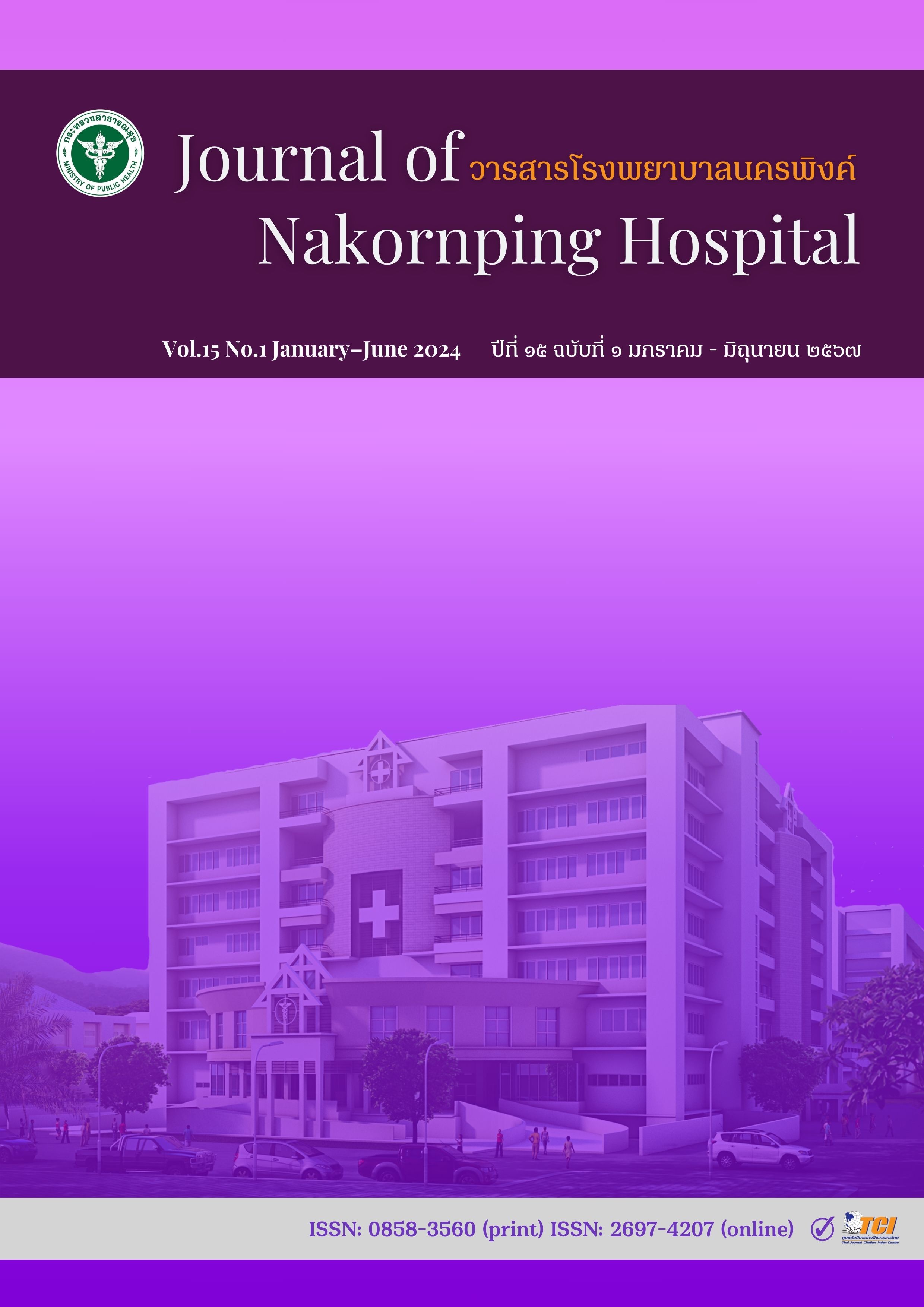ปัจจัยที่มีความสัมพันธ์ต่อการติดเชื้อร่วมของโรควัณโรคและโรคโควิด-19 ในโรงพยาบาลนครพิงค์ จังหวัดเชียงใหม่
คำสำคัญ:
ผู้ป่วยวัณโรค, ผู้ป่วยโควิด-19, การติดเชื้อร่วมบทคัดย่อ
การวิจัยครั้งนี้เป็นการศึกษาย้อนหลัง (Retrospective Cohort study) มีวัตถุประสงค์เพื่อศึกษาความชุกและปัจจัยของการติดเชื้อร่วมโรควัณโรค และโรคโควิด-19 ในผู้ป่วยวัณโรคที่ขึ้นทะเบียนรักษาในโรงพยาบาลนครพิงค์ จังหวัดเชียงใหม่ ประชากรที่ศึกษา คือ ผู้ป่วยวัณโรคที่ขึ้นทะเบียนรักษาที่โรงพยาบาลนครพิงค์ ระหว่างเดือนมกราคม 2564 ถึง กันยายน 2565 จำนวน 388 คน ด้วยการรวบรวมข้อมูลทุติยภูมิของผู้ป่วยโรควัณโรคจากโปรแกรมรายงานข้อมูลวัณโรคของประเทศไทย (Nation Tuberculosis Information Program : NTIP) และใช้ข้อมูลทุติยภูมิของผู้ป่วยโรคโควิด-19 จากโปรแกรม Epid-CM Dashboard การวิเคราะห์ข้อมูลใช้สถิติ Binary logistic regression analysis เพื่อหาปัจจัยที่มีความสัมพันธ์ต่อการติดเชื้อร่วมของโรควัณโรคและโรคโควิด-19
ผลการศึกษา พบว่า ผู้ป่วยวัณโรค 388 คน เพศชาย 258 คน ร้อยละ 66.5 เพศหญิง 130 คน ร้อยละ 33.5 อายุเฉลี่ย 49.24 ± 17.95 ปี เป็นผู้ป่วยวัณโรคปอด 281 คน ร้อยละ 72.4 วัณโรคนอกปอด 107 คน ร้อยละ 27.6 พบความชุกของการติดเชื้อร่วมของโรควัณโรคและโรคโควิด-19 ร้อยละ 4.12 (16 ราย) ปัจจัยที่มีความสัมพันธ์ต่อการติดเชื้อร่วมของโรควัณโรคและโรค โควิด-19 ได้แก่ สิทธิการรักษา และประเภทการขึ้นทะเบียนของผู้ป่วยวัณโรค โดยที่ผู้ป่วยที่ใช้สิทธิการรักษาประเภทประกันสังคม (Adjusted Odd Ratio 5.17, 95% CI: 1.15-23.38) สิทธิการรักษาประเภทข้าราชการ/รัฐวิสาหกิจ (Adjusted Odd Ratio 6.81, 95% CI 1.20-38.53) มีการติดเชื้อร่วมมากกว่าผู้ป่วยที่ใช้สิทธิการรักษาประกันสุขภาพถ้วนหน้า และผู้ป่วยวัณโรคที่ขึ้นทะเบียนประเภทผู้ป่วยกลับเป็นซ้ำ/รักษาซ้ำหลังจากขาดยา (Adjusted Odd Ratio 7.24, 95% CI 1.69-30.97) มีการติดเชื้อร่วมมากกว่าผู้ป่วยรายใหม่อย่างมีนัยสำคัญ
สรุปผล การให้ความสำคัญด้านความรู้ แนวทางการป้องกันและดูแลตนเอง ในกลุ่มผู้ป่วยที่ใช้สิทธิการรักษาประกันสังคม สิทธิการรักษาประเภทข้าราชการ/รัฐวิสาหกิจ และผู้ป่วยกลับเป็นซ้ำ/รักษาซ้ำหลังจากขาดยา อาจช่วยในการป้องกันการติดเชื้อร่วมของโรควัณโรคและโรคโควิด-19
References
Bureau of tuberculosis. Guidelines for Prevention and Control of tuberculosis transmission, vol1. Bangkok: Aksorn graphic and design publishing limited partnership; 2016. [In Thai]
World Health Organization. Global Tuberculosis Report 2022 [Internet]. Switzerland: World Health Organization; c2022 [update 2024 Jan 18; cited 2022 Sep 14] Available from: https://www.who.int/teams/global-tuberculosis-programme/tb-reports/global-tuberculosis-report-2022/covid-19-and-tb
World Health Organization. Global tuberculosis report 2019 [Internet]. Switzerland: World Health Organization; c2019. [update 2019 Oct 15; Cited 2024 Feb 9]. Available from: https://www.who.int/publications/i/item/9789241565714
Chiang Mai Provincial Public Health Office. Performance report form Operate according to the government inspection and supervision plan in normal cases, Round 2/2023 Health Zone 1 : Chiang Mai Province [Internet]. [update 2023 Jun 6; cited 2024 Feb 9]. Available from: https://www.chiangmaihealth.go.th/document/230616168691487670.pdf [In Thai]
World Health Organization. Global tuberculosis report 2021 [Internet]. Switzerland: World Health Organization; c2021. [update 2021 Oct 14]. Available from: https://www.who.int/publications/i/item/9789240037021
World Health Organization. COVID-19 Weekly Epidemiological Update [Internet]. Switzerland : World Health Organization; c2021 [update 2021 Feb 23; Cited 2022 Aug 15]. Available from: https://www.who.int/publications/m/item/weekly-epidemiological-update---23-february-2021
Worldometers. COVID-19 Coronavirus pandemic [Internet]. [Cited 2022 Jun 16] Available from: https://www.worldometers.info/coronavirus/
Situation Command Center, Chiang Mai Province (M.P.P). Covid-19 Outbreak in Chiang Mai [Internet]. [Cited 2024 Feb 20]. Available from: https://www.chiangmai.go.th/covid19/assets/img/situation/300464.jpg [In Thai]
Department of Disease Control. Situation of coronavirus disease 2019 (COVID-19) Public health measures and obstacles to disease prevention and control in travelers [Internet]. [update 2021 Aug 8; cited 2024 Feb 7]. Available from: https://ddc.moph.go.th/uploads/files/2017420210820025238.pdf
World Health Organization. Global Tuberculosis Report 2022: COVID-19 and TB [Internet]. Switzerland : World Health Organization; c2022 [update 2024 Jan 18; cited 2022 Sep 14] Available from: https://www.who.int/teams/global-tuberculosis-programme/tb-reports/global-tuberculosis-report-2022/covid-19-and-tb
Song WM, Zhao JY, Zhang QY, Liu SQ, Zhu XH, An QQ, et al. COVID-19 and Tuberculosis Coinfection: An Overview of Case Reports/Case Series and Meta-Analysis. Front Med (Lausanne). 2021;8:657006. doi: 10.3389/fmed.2021.657006.
Wang Q, Guo S, Wei X, Dong Q, Xu N, Li H, et al. Global prevalence, treatment and outcome of tuberculosis and COVID-19 coinfection: a systematic review and meta-analysis (from November 2019 to March 2021). BMJ Open. 2022;12(6):e059396. doi: 10.1136/bmjopen-2021-059396.
Tadolini M, Codecasa LR, García-García JM, Blanc FX, Borisov S, Alffenaar JW, et al. Active tuberculosis, sequelae and COVID-19 co-infection: first cohort of 49 cases. Eur Respir J. 2020;56(1):2001398. doi: 10.1183/13993003.01398-2020.
TB/COVID-19 Global Study Group. Tuberculosis and COVID-19 co-infection: description of the global cohort. Eur Respir J. 2022;59(3):2102538. doi: 10.1183/13993003.02538-2021.
Emergency Public Health Division Office of the Permanent Secretary, Ministry of Public Health. Report on lessons learned from preparation for the 2019 coronavirus outbreak. Health district level [Internet]. c2022 [update 2023 Jan 13, cited. 2024 Feb 24]. Available from: https://mahidol.ac.th/documents/covid19.pdf [In Thai]
Chiang Mai Provincial Public Health Office. Order of the Chiang Mai Communicable Disease Committee [Internet]. [Cited 24 Feb. 2024]. Available from: https://www.chiangmai.go.th/covid19/command.html [In Thai]
Mishra A, George AA, Sahu KK, Lal A, Abraham G. Tuberculosis and COVID-19 Co-infection: An Updated Review. Acta Biomed. 2020;92(1):e2021025. doi: 10.23750/abm.v92i1.10738.
Kumwichar P, Chongsuvivatwong V. COVID-19 pneumonia and the subsequent risk of getting active pulmonary tuberculosis: a population-based dynamic cohort study using national insurance claims databases. EClinicalMedicine. 2023;56:101825. doi: 10.1016/j.eclinm.2023.101825.
Mangamba LE, Sike CIM, Tochie JN, Dalle GN, Nkouagmi N, Balkissou AD, et al. Prevalence of tuberculosis/COVID-19 co-infection and factors associated with SARS-CoV-2 infection in pulmonary tuberculosis patients at a respiratory diseases center: a cross-sectional study. Pan Afr Med J. 2023;44:204. doi: 10.11604/pamj.2023.44.204.38541.
Teerawit P. Pulmonary tuberculosis [Internet]. c2013 [update 2013 Feb 2; cited 2022 Sep 14]. Available from: https://www.rama.mahidol.ac.th/med/sites/default/files/public/pdf/medicinebook1/TB.pdf [In Thai]
Downloads
เผยแพร่แล้ว
How to Cite
ฉบับ
บท
License
Copyright (c) 2024 โรงพยาบาลนครพิงค์

This work is licensed under a Creative Commons Attribution-NonCommercial-NoDerivatives 4.0 International License.
บทความที่ได้รับการตีพิมพ์เป็นลิขสิทธิ์ของโรงพยาบาลนครพิงค์ จ.เชียงใหม่
ข้อความที่ปรากฏในบทความแต่ละเรื่องบทความในวารสารวิชาการและวิจัยเล่มนี้เป็นความคิดเห็นส่วนตัวของผู้เขียนแต่ละท่านไม่เกี่ยวข้องกับโรงพยาบาลนครพิงค์ และบุคลากรท่านอื่นๆในโรงพยาบาลฯ ความรับผิดชอบเกี่ยวกับบทความแต่ละเรื่องผู้เขียนจะรับผิดชอบของตนเองแต่ละท่าน


